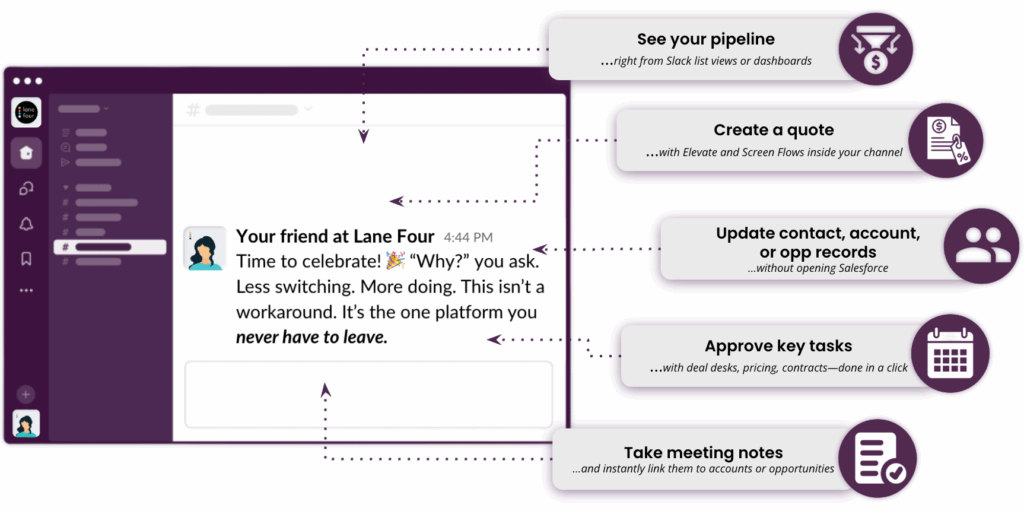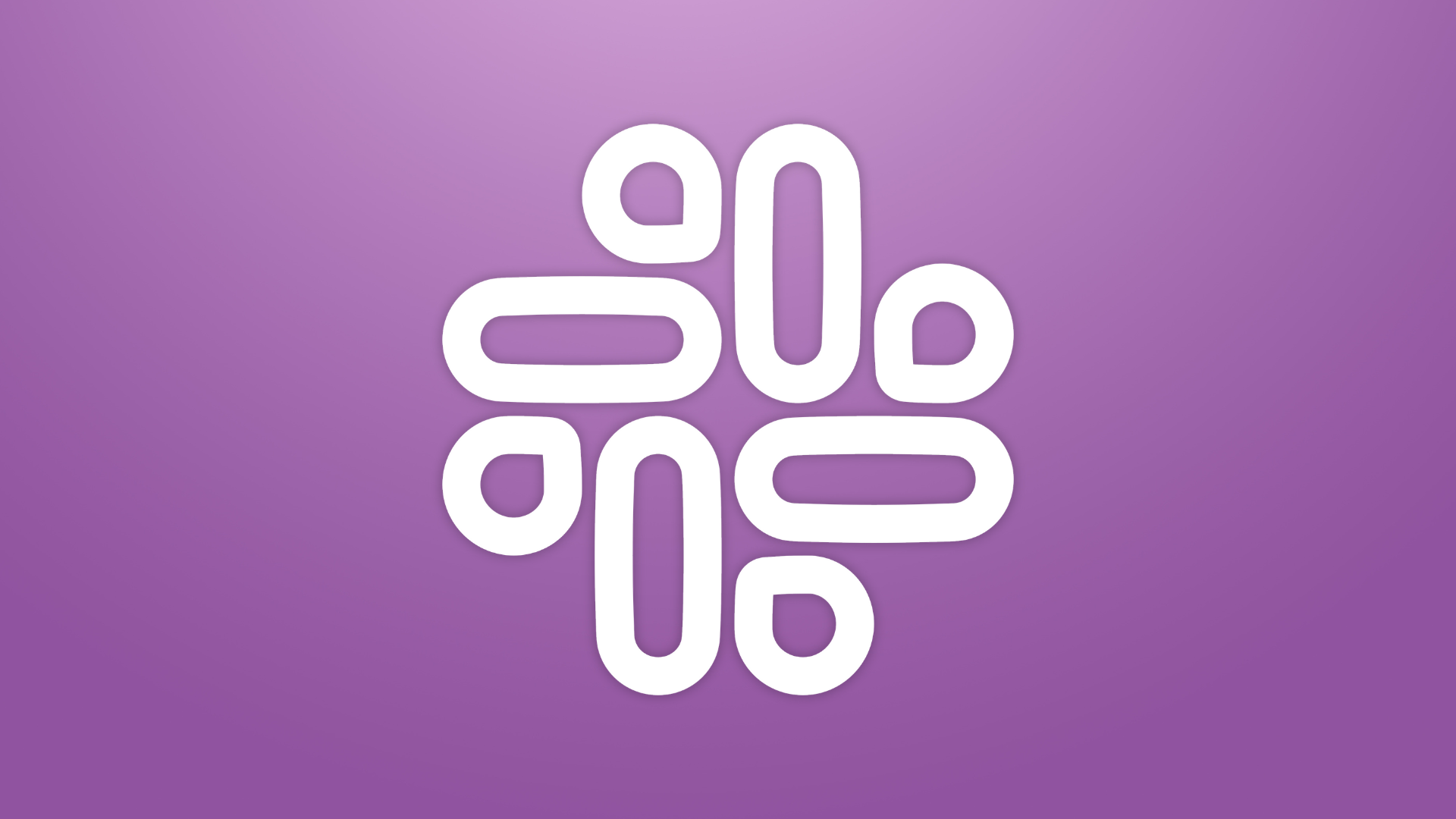Have you opened Slack recently and realized how it’s quietly evolved from just a chat tool to something… more? Maybe it wasn’t sudden. Or maybe it wasn’t quiet (if you’ve actually been following along). But if you were looking for a tool where approvals, record updates, dashboards, and workflows, can all happen without leaving the system, (with even more capability announcements at Dreamforce ’25) Slack is the place.
It used to be a bridge, somewhere to ping your team or check a deal but now with Slack Sales Elevate, Screen Flow capabilities, Agentforce AI, and Salesforce Channels, it is becoming the workspace where work actually happens. From what we have seen, that shift changes everything, so let’s take a closer look at what it actually means day to day.
Is Your Team Using Slack Just to Chat?
Slack Sales Elevate isn’t just another update. Like we said, it’s changing how sales teams actually work. Opportunity lists, stage changes, and dashboards now show up right in the channels where people are already collaborating. No more tab hopping in Salesforce or waiting until “later” to update within the instance. From what we have seen, when data lives where the work happens, adoption follows naturally and decision making feels faster, smoother, and more intuitive.
What’s especially interesting this time around is how far Slack is starting to stretch beyond just conversation; something it’s long done, and done exceptionally well. But if we’re being honest, ever since Salesforce officially acquired the platform nearly five years ago, it felt inevitable that Slack would evolve into more of a workflow and efficiency tool for people already enabled in the Salesforce ecosystem.
With Agent Employee Templates, for example, you can now create Slack agents that handle repetitive Salesforce tasks for you. Instead of jumping between records or chasing down status updates, you just ask Slack. We have seen teams use these to pull live data, push updates, and even trigger workflows, all without leaving the thread they are in. It may seem like a small shift, but it changes how people show up to work every day.
Then there is the new Slack Channel Expert, an AI teammate that can answer questions based on what has happened in a channel including conversations, notes, and documents. It is like having someone in the room who always remembers the details. That kind of context does not just make life easier, it keeps momentum going.
Salesforce Channels takes it one step further. Every conversation tied to an Opportunity or Account now automatically links to the right record. Files, notes, and updates all stay connected. The benefit is subtle but powerful. No one wastes time searching for the “latest version,” and cross functional miscommunication drops off almost completely.
And with Screen Flows, the work keeps moving. While this feature was something that emerged a few years back, showing and enabling our customers to create quotes, onboarding customers, or updating deals can all happen directly in Slack. What used to mean multiple tabs and a trail of follow up messages has turned into a single, shared workspace where progress actually happens in real time.
When we look at some of these updates together, it is clear that Slack is not just a place to talk anymore. It is becoming the place where revenue work lives, and that shift changes everything.
AI in Slack It Is Not Just Hype
Surprise, suprise…the talk about AI continues! AI in Slack is not about flashy features, it is about helping work actually flow. Need a quick pipeline summary before a meeting? You no longer have to pull a report. Just ask Slack. Need to catch up after being away? Slack AI can now summarise conversations and surface what matters most without the endless scroll.
When set up correctly, what we have noticed is that these small touches start to build habits. Teams stay more informed. Updates happen in real time. Managers no longer have to chase status reports because the answers are already in the thread.
Even approvals are easier. When a deal comes through, the workflow triggers, and the manager reviews and approves it right there in Slack. Salesforce updates automatically. No delays, no missed steps, just work moving at the pace of conversation.
It is the kind of AI that feels invisible but makes everything feel lighter. And when teams start relying on it, the result is not just productivity, it is confidence.
Slack as Your New Front Door
The old routine meant juggling Salesforce tabs, clicking through endless screens, and constantly shifting focus. It got the job done, but not without slowing things down.
Now, it is simpler. Need a quote approved? Your manager can review it right in the channel. Kicking off a new customer onboarding? Tasks are automatically assigned, owners are notified, and notes are logged without ever leaving Slack. Even during a pipeline check, stage updates, metrics, and blockers appear right where you are already working.
Everything happens in one workspace. The friction fades, teams move faster, and leaders get the visibility they need without chasing updates. From what we have seen, these kinds of changes do not just boost efficiency, they make adoption feel effortless.

Why This Matters
At the end of the day, features only matter if they make work feel smoother. What really changes things is when context lives right where decisions happen. Forecasts get closer to reality because everyone is looking at the same data. Bottlenecks become visible the moment they form, not after the quarter closes. Approvals move faster because they happen in the same space where the conversation started.
It is subtle, but it adds up. Managers start spotting coaching moments in real time. Teams can track performance without chasing reports. And suddenly, the pipeline does not just look healthy on paper. It feels easier to manage because everyone is in sync.
When work, communication, and insight all live in one place, efficiency is not forced. It happens naturally. And the teams that get there first often find that confidence in their revenue follows.
The Old Way versus The Slack Way
Getting one task done used to mean juggling eight tabs, waiting on updates, and hoping nothing slipped through the cracks. Those days are fading. Now, opportunity lists, quote creation flows, and record updates can all happen directly in Slack. Notes are logged, approvals are completed, and work moves forward in the same space where conversations are already happening.
It feels cleaner, faster, and more natural. Teams do not just talk, they execute. And when the work lives where people already collaborate, adoption tends to follow on its own.
Slack is no longer just a chat tool. It has become the hub where collaboration, execution, and insights converge. The question is not whether Slack can do more…it already does. It is whether your team is ready to make it the front door for work, where Salesforce, AI, and workflows connect seamlessly.
We have seen what happens when teams bring their processes into Slack and let the work flow naturally. Curious what that could look like for your organisation? Let’s chat!
